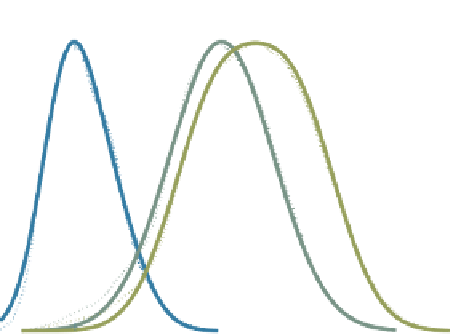Image Processing Reference
In-Depth Information
1
L
L
L
L
L
M
M
M
M
M
S
S
S
S
S
0.8
0.6
0.4
0.2
440
440
440
440
440
540
540
540
540
540
570
570
570
570
570
0
400
450
500
550
600
650
700
Wavelength, nm
Fig. 2.1. The graph illustrates the sensitivity curves of S-, M-, and L-cones of the retina to the
wavelength of the stimulating light
humans become more sensitive to longer wavelengths (yellow and orange) than short
wavelengths (cyan and blue). In addition to decreased sensitivity to blue, with aging
our general light sensitivity also decreases.
2.2 Retina and Color
The retina has sensor cells, called
cones
and
rods
, that react to photons. Rods require
very small amounts of photons to respond compared to cones. Rods also respond
to a wider range of wavelengths of photons. Within their range of received photon
amounts, that is the
light intensity
, both cone and rod cells respond more intensely
upon arrival of more light photons. Humans rely on cones for day vision, whereas
they use rod sensors, which are wavelength-insensitive in practice, for night vision.
This is the reason that we have difficulty perceiving the color of an object at dark,
even though we may be perfectly able to recognize the object. By contrast, the cones,
which greatly outnumber the rods in the retina, are not only sensitive to the amount
of light, but are also sensitive to the wavelength of the light. However, they also
require many more photons to operate, meaning that the cones are switched “off” for
nightvision, and they are “on” for dayvision.
Cones belong to either L-, M-, or S- types representing long, middle and short
wavelengths. These categories have also been called red, green and blue types mak-
ing allusion to the perceived colors of the respective wavelengths of the cells. How-
ever, studies in neurobiology and psychology have shown that the actual colors the
top sensitivity of the cones represent do not correspond to the perceptions of red,






































